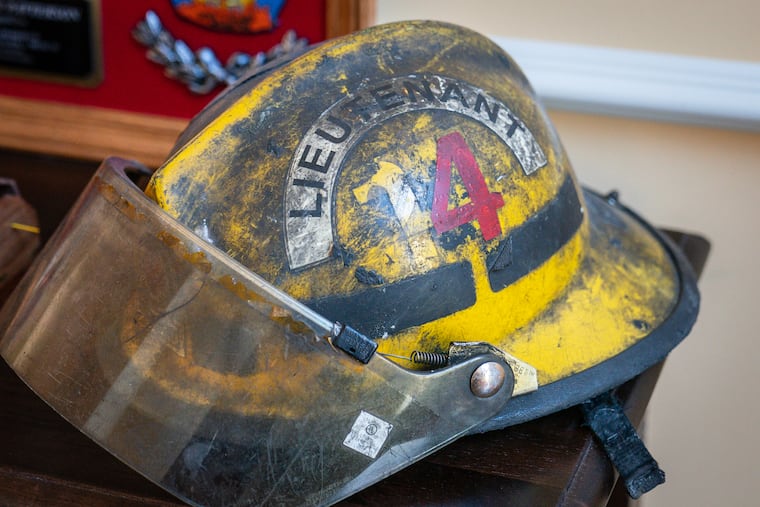What you need to know about firefighter deaths, cancer, and ‘forever chemicals’
Cancer is a leading cause of death for firefighters, likely due to toxic exposures from battling fires, but many now worry that their illnesses may be tied to their protective gear.

Any time they answer an alarm call, firefighters face an array of possible dangers: searing flames, collapsing buildings, suffocating smoke. A leading cause of death for firefighters, though, is cancer, likely due to exposure to toxic chemicals while battling fires.
Across the United States, many firefighters now worry that their illnesses may be traced to something that is supposed to protect them: their turnout gear. Researchers have found that the gear has for years contained PFAS (per- and polyfluoroalkyl substances), which are associated with kidney and testicular cancer, liver damage, decreased fertility and immunity, and increased risks of asthma and thyroid disease.
The Inquirer interviewed firefighters, in Philadelphia and across the country, who are battling cancer, and explored how some cities and states are attempting to protect firefighters from being exposed to PFAS.
How prevalent is cancer among firefighters?
The International Association of Fire Fighters, a union that represents 334,000 members in the U.S. and Canada, said it added the names of 261 active-duty firefighters to its memorial wall last year. Of that total, nearly two-thirds had died of cancer.
A study in the Journal of Occupational Medicine, published this year, found cancer death rates among Scottish firefighters to be 1.6 times higher than the general population. Rates of prostate cancer and leukemia appear to be more than three times higher than the norm.
PFAS — so-called forever chemicals — can be inhaled or absorbed through the skin, and remain in the body for years. Chemical companies’ internal records show that the manufacturers have known for decades that some PFAS are “highly toxic” when inhaled.
How do we know that PFAS is in firefighting gear?
Graham Peaslee, a physicist at the University of Notre Dame who has spent years studying PFAS compounds, tested 43 pieces of turnout gear, beginning in 2018.
What he found, he said, were the highest levels of PFAS he’d ever seen in any textile. Peaslee was particularly alarmed to find that PFAS from the firefighters’ gear had been transferred to his students’ hands. “We saw a measurable transfer just from rubbing it onto our hands,” he recalled. “A significant quantity. This was startling.”
Peaslee also tested dust from 15 firehouses and found that areas with the highest levels of PFAS were ones where the firefighters lived and the turnout gear was stored.
Why would companies use chemicals that have been linked to cancer to manufacture firefighters’ protective gear?
Manufacturers have used PFAS, a water repellant, in turnout gear for more than two decades. In 2007, the National Fire Protection Association (NFPA), an international fire codes organization, adopted a standard for the moisture barrier — the middle layer of the turnout gear designed to repel water and oil — that requires it to withstand ultraviolet light for 40 hours without degrading.
The decision was based in part on a 2000 master’s thesis written by a University of Kentucky graduate student whose adviser had received at least $50,000 in funding from chemical companies that manufacture PFAS, and from firefighting apparel companies that use the chemicals in gear.
The NFPA stresses that it doesn’t dictate the use of any particular material or chemical in the gear. That’s up to manufacturers, the organization says.
But until April, PFAS-treated textiles were the only material that could withstand the ultraviolet test.
Is this standard being challenged?
Yes. The firefighters union sued the NFPA in March, claiming that the global group ignored scientific evidence and downplayed health hazards that the chemicals pose when it adopted the standard.
Union leaders say they want manufacturers to produce turnout gear and firefighting foam that are free from PFAS, and for the NFPA to drop its “arbitrary and unreasonable” standard.
The NFPA calls the lawsuit “misguided and ill-informed.”
Are people outside the firefighting profession exposed to PFAS?
PFAS exist in a range of everyday items, from nonstick cookware and stain-resistant carpets to waterproof clothing and artificial turf.
In March, the EPA called for legally enforceable limits on six widely used PFAS that have contaminated water systems across the U.S. and are considered unsafe to drink at virtually any level. The chemical company 3M recently agreed to pay as much as $12.5 billion to settle lawsuits that Philadelphia and other municipalities have filed, alleging that public drinking water has been contaminated by PFAS.
What are Philadelphia officials saying in response to firefighters’ concerns about PFAS?
Sarah Peterson, a spokesperson for Mayor Jim Kenney, said the city tries to mitigate cancer risks through personal protective equipment, educational awareness, and physical exams, and is transitioning away from firefighting foam containing PFAS, a product now banned for training use in at least a dozen states.
Peterson said the Fire Department hasn’t found low-PFAS gear that would provide firefighters “with the same level of protection they get from their current gear.”
How are other cities and states addressing this issue?
In Nantucket, Ma., officials have spent $161,668 on turnout gear that contains lower amounts of PFAS, and moved their firefighters into a new headquarters.
Rhode Island’s House Finance Committee is reviewing a proposal that would allocate $15.2 million for PFAS-free firefighting gear.
In Washington state, manufacturers can still sell firefighting gear that contains PFAS, but must disclose its presence to buyers. And Indiana lawmakers are advancing legislation that would require 1,000 current and retired firefighters to undergo bio-monitoring to measure their PFAS exposure.
Do any manufacturers offer PFAS-free gear?
Stedfast, a Canadian-based manufacturer, announced in April that it had developed a PFAS-free moisture barrier for turnout gear. It’s unclear when the product would be available for fire departments to purchase.